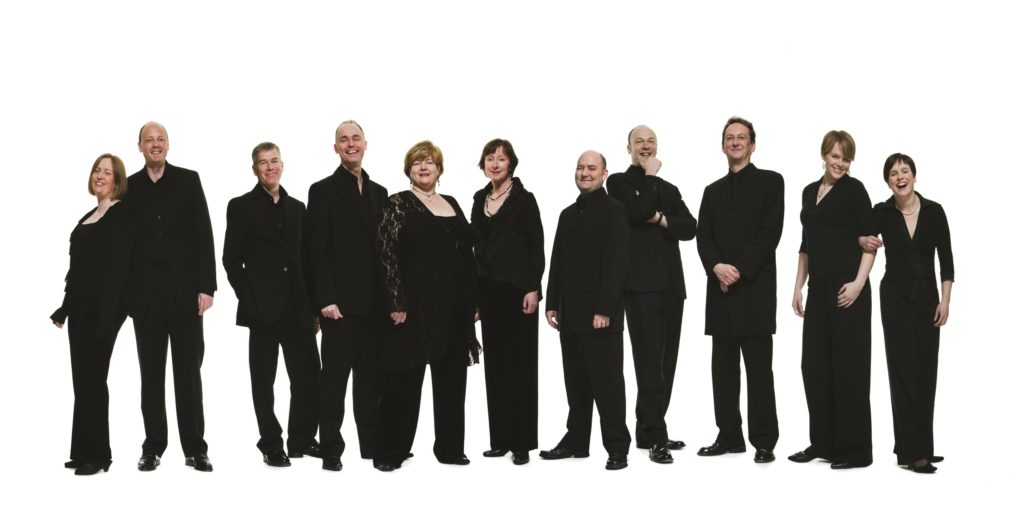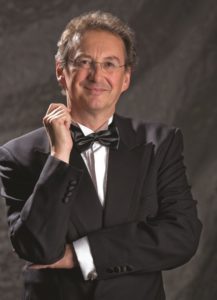The Art of Singing One Voice to a Part
An Occasional Series of ICB Interviews
Graham Lack
composer & ICB Consultant Editor
Joe Roesler, of the Calmus Ensemble
Graham Lack: Thank you so much for taking the time to talk to us. I hope that Skype was not too much an invasion of your privacy…
Joe Roesler: Not at all, it’s a pleasure, and good to see a face, too.
GL The first question sounds pretty simple, but might be a bit trickier than you think: when you rehearse, say, a largely homophonic piece, how do you get each chord in tune?
JR Generally I think we examine each new harmony as it appears in the work and then let it grow and ripen. By ‘examine’ I mean that we subject it to various tools of the trade. Sometimes we hold it for much longer than written, so that it is extremely attenuated, and this allows us to ‘hear out’ the harmonic structure. Another way to get the chord right is to leave out a potentially problematic pitch. Often we have an intuitive feeling about which note in the chord is the ‘culprit’. We home in on it and quite quickly agree to try the harmony without that note. Then we know where the problem lies. Occasionally we build the chord up from the bass, each voice adding the appropriate note until the chord is in tune and balanced.
GL I’ll come back to the idea of ‘balance’ in a minute. So, if it is more often than not a single note in a chord that is causing the harmony to sound sour, how do you account for that at a theoretical level? What conclusions do you usually draw?
JR Most of the time it is the third of course. Frequently it lies too low or too high, and we are often able to carry out a quick fix. But there are times where the third seems to be behaving, and we need to seek elsewhere…
GL Like for an octave, a fourth, or a fifth?
JR Absolutely. Assuming we are dealing with basically tonal, homophonic music, the structure of the overtone series…
GL …based as it is on a fundamental, an octave, a perfect fifth, perfect fourth, major third and minor third et cetera…
JR quite…it is the structure of the overtone series that determines how a chord is built and how it functions. Usually there is a fundamental that is doubled somewhere above, then one note that forms a fifth or a fourth with its neighbours, and then just one note with the function of the third.
GL Are some notes less important than others?
JR For sure. The lower the note in the overtone series, the more importance it generally assumes in the chord.
GL Bearing in mind that you are a five-voice ensemble, if the fundamental occurs three times in a five-part chord and there is only one note acting as a fifth to that fundamental or as a fourth to another note – including compound intervals of course –, and there is but a single third, surely the octaves or double octaves above that fundamental would take on too much importance?
JR Of course, there is a huge danger that the chord itself would become very unbalanced, with some notes too loud for their own good. So it is vital that we each know the function of our own note, and what exactly it is doing in the chord. We need to know its relationship to the basic triad, its place in the overtone series, and what other notes it is strengthening.
GH Which brings us neatly on to overtones.
JR The stuff of music…
GL …exactly…so if a chord is in tune, why might it still sound ugly?
JR There may well be other faults in the way the ensemble is singing. The chord might be unbalanced, as I said just now, and a single note might simply be too loud. So we experiment with that. But there is also the question of the vowels we sing…
GL …where there might not be full agreement perhaps?
JR Yes, this is another problem all small vocal ensembles singing one voice to a part will encounter at one point or another.
GL So how do you deal with this issue and what happens exactly to the sound if some singers produce one vowel and others produce a different one at any one point in a piece?
JR It depends on the language in which we are singing, and this may vary between Latin, Greek, German, Italian and, recently, Croatian. But these pronunciation problems are usually quickly solved, as we have recourse to experts both within and without the ensemble. The real issue is that we all simply sing the same vowel.
GL And why is that so important?
JR Because every vowel, regardless of the language in which we happen to be singing, produces a certain sound colour, or ‘timbre’. We call it Klangfarbe in German of course. And if each singer produces a differently coloured vowel, just like when executing a painting – and I hope that is not too primitive an example – then the result will be disagreeable or just terribly muddied.
GL Like garish colours, or where it all results in a kind of brown?
JR Yes, that’s exactly what happens. We really must all sing exactly the same vowel simultaneously, and this vowel must be as pure as possible.
GL Any vowel is made up of two so-called formants. Or at least each vowel is to all extents and purposes governed by these two peaks in the signal, ones which are there for but a fleeting moment in time as each discrete sound becomes audible.
JR And this is where theoretical knowledge plays a part in our rehearsal, well, I guess any ensemble’s rehearsal for that matter. It really is vital to understand what vowel one is singing, whether or not it is still pure, and what is actually going on in terms of frequencies when singing it…
GL …formants being measured in milliseconds and in Hertz along two axes of the graph of musical time and space…
JR …yes, it’s interesting to learn about how an acoustic signal can be displayed on the page…and so it is these sound colours that make a chord sound nice or, quite frankly, unpleasant for the listener.
GL It’s all a trick of the ear of course, and once the formants have appeared, and almost immediately disappeared, we only think we are still listening to the same vowel, even when what is left over is a sinus tone.
GL But to return to intervals and the harmonic series. The seventh – be it major or minor – played an increasingly important harmonic role in the history of music, especially from the late 19th century onwards and throughout the 20th.
JR Well, a seventh chord does seem to be one of those ‘obvious’ and somewhat overworked sounds. Composers still rely on it today. We call all added notes the ‘harmonic dirt’, just our little in-joke.
GL The major seventh chord can certainly liven up an orthodox passage, or indeed seem trite and almost embarrassing.
JR The trick is not to make too much of it…
GL …don’t milk it as it were…
JR …quite, generally, any added-note harmony we approach with a sense of caution, and put much less emphasis on notes which function as, say, an added sixth, an added seventh or a ninth or whatever.
GL Which proves the point that the higher up the harmonic series a particular pitch class is found, the less important its role in the harmony itself.
JR That is how we hear things in any case. Calmus has been singing quite a number of works by Harald Banter recently.
GL A pretty good name for a composer.
JR Why is that?
GL Because it means light-hearted and witty ‘chit-chat’ in English.
JR I see. You learn something new every day.
GL Where were we? Yes, I know, the ‘dirty’ notes in the harmony, and Banter…
JR …right. In his music, there is very often a minor seventh between bass and baritone, the two lowest parts, and we ended up calling this the ‘Banter octave’, because it seems to take on this function without ever actually becoming one of course.
GL So how does this affect the other singers?
JR It makes it hard for them, and it is quite off putting when one sings. The others are constantly striving to hear an octave in the low voices, but it is simply not there. The fundamental is just not doubled, nowhere at all! Life can be tough sometimes.
GL Talking about difficult things, what about enharmonic changes?
JR This is one of the real bugbears in a cappella singing with just one voice to a part. The harmonic framework of any piece we sing is incredibly sensitive to the tiniest fluctuations in pitch within any chord. And nowhere is it more susceptible than where enharmonic change is used to get from one chord to the next. But we have no fixed rules in Calmus and examine each case as it comes along. Sometimes we need to let the fundamental of one chord become the major third in the next – but only where it is the same pitch class, and sometimes we are able to shift what was a fundamental note in one chord up or down so it takes on a new role in the next harmony, but only as long as there is neither an immediate unison relation nor octave equivalence.
GL The work of Euler comes to mind of course.
JR Gosh, yes, and one could spend the day just marking pitches that need to be inflected upwards or downwards.
GL But you do acknowledge that his system can be of immense use?
JR Of course, but there is the danger that an entire work ends up a long way from home, either on the flat side of things or the sharp.
GL I hope the readers have not lost us here, it’s probably best to ask them to go and Google him or whatever…
JR …oh sure, Euler is certainly worth reading. Just make sure you can still see the wood for the trees!
GL That’s my experience too, read him, think about it, and apply his ideas in just one rehearsal, to get singers to think about the role their notes play in passages of extreme enharmonic change. After that, put it behind you and trust your ear, otherwise nothing will ever sound in tune again!
GL Finally, and to leave music theory for a minute, how would you describe the overall atmosphere of a Calmus rehearsal?
JR I think there are two watch-words, things which anyone present would connect with our work: time, and intensity.
GL Meaning?
JR That we have the luxury of time itself, and we are able to bring large amounts of this valuable commodity to the rehearsal. Good music-making takes lots of time. There is no way around that. Also, we talk a lot about the ‘intensity’ of the performance and the sound we are making. This is a key idea and describes well the way we sing…it is no trade secret really.
GL And what happens in rehearsal when you learn a new work?
JR We talk a great deal, and we talk a great deal about ‘intensity’. This is not a waste of time. The time that outsiders might think we are losing is time that gets paid back to us further down the line. As for ‘intensity’, this is I suppose a largely ephemeral idea, but in practice it turns out to mean just how much each singer contributes to the overall sound. This is our hotbed of new ideas. And this is how we arrive at our interpretations, ones we feel that make Calmus and the Calmus sound special.
GL It’s not like working in a small chamber choir then?
JR Quite the opposite, we all have a chance to contribute, and while there will be many smaller choirs out there, ones in which contributions and interpretive ideas from the members are welcomed by the conductor, some decisions will favour the few, and some the many. So, all I can say is that we bring time, use time, rely on time, and try to gauge the intensity with which we control our own performance within an ensemble…
GL…one where a single voice sings a single part…
JR …where one voice has its very own part. It’s a luxury I know…
GL…but one which other, larger groups and choirs might find time to indulge in…
JR My thoughts exactly.

Peter Philips, of the Tallis Scholars
Graham Lack: This will sound like quite a simple question, but one which reveals how different polyphonic music can sound when sung by a vocal soloists, a large ensemble or a small chamber choir: how would you explain the basic difference between singing a work with just one voice one to a part and with more than one singer per part?
Peter Philips: The greatest difference is between singing one to a part and two to a part, after that the disparity decreases with the numbers involved. With one to a part, the ensemble should be really good, since all the singers are closely in touch with each other. With two, the sense of ensemble should still be good, since the two voices on each part are right next to each other. The problem of balance and coordination with three or more voices to a part arises because two singers are not standing next to each other, and thus cannot react immediately to what the other voices on the line are doing. Actually I generally consider two voices to a part superior to one to part because two singers can stagger the breathing, and sing long lines legato without there being any apparent breaks, which is inevitable with only one singer holding the line. This legato does not really apply to a lot of secular music, but it is essential to the big antiphons and mass-settings of the sacred repertoire.
GL What issues arise with this kind of performance and how do they relate to performance practice?
PP Simply put, one voice to a part should yield the best tuning, but not the best blend. Two voices should yield excellent tuning, since everyone is closely in touch with each other, and very good blend, since each pair is obliged to listen to the neighbouring voice all the time, and this in turn makes it easier to intermingle within the whole group. A solo voice per part will inevitably have timbres that stick out. It is probable that three or even more voices to a part will give good blend, but in my experience the blend rapidly becomes ill-focussed. At the end of the day it is not a very exciting kind of blend, too amorphous. But I do accept that three or four voices could blend well, given the right mentality amongst all the singers, and a not too reverberant building.

GL As for general musical style, what approaches do you take?
PP We only ever sing Renaissance music, with one or two modern composers mixed in when they have either written for us, or I think their style suits our kind of programme. Arvo Part’s music falls into the latter category, and John Tavener’s in the former.
GL What are your thoughts on using all male voices without countertenors, male voices with countertenors, mixed voices with altos but without sopranos, and mixed voices SATB?
PP We always go on stage with a basic SATB choir, which can then subdivide for a piece or two. We hardly ever sing with tenors and basses alone. We always sing with men and women mixed.
GL Is there anything else you would like to say? I’m sure ICB readers are open to all kinds of advice.
PP The only other thing to mention in the matter of blend and general detail are the acoustics of the building. The general public hails reverberant churches as ideal spaces in which to sing. Actually they can destroy polyphony, which relies entirely on the kind of detail one finds in chamber music for its interest. In very reverberant acoustics such music can blur into a succession of not very interesting chords. It also makes it much harder for the singers to hear each other, and so agree on an interpretation. Very dry places can be hell for the voice, but some of the drier ones at least create the circumstances in which a sensitive and interesting performance can take place, where the singers are fully in control of what they are doing. My favourite venues for sacred polyphony are modern symphony halls, where the acoustician has produced a clear and rounded basic sound.
